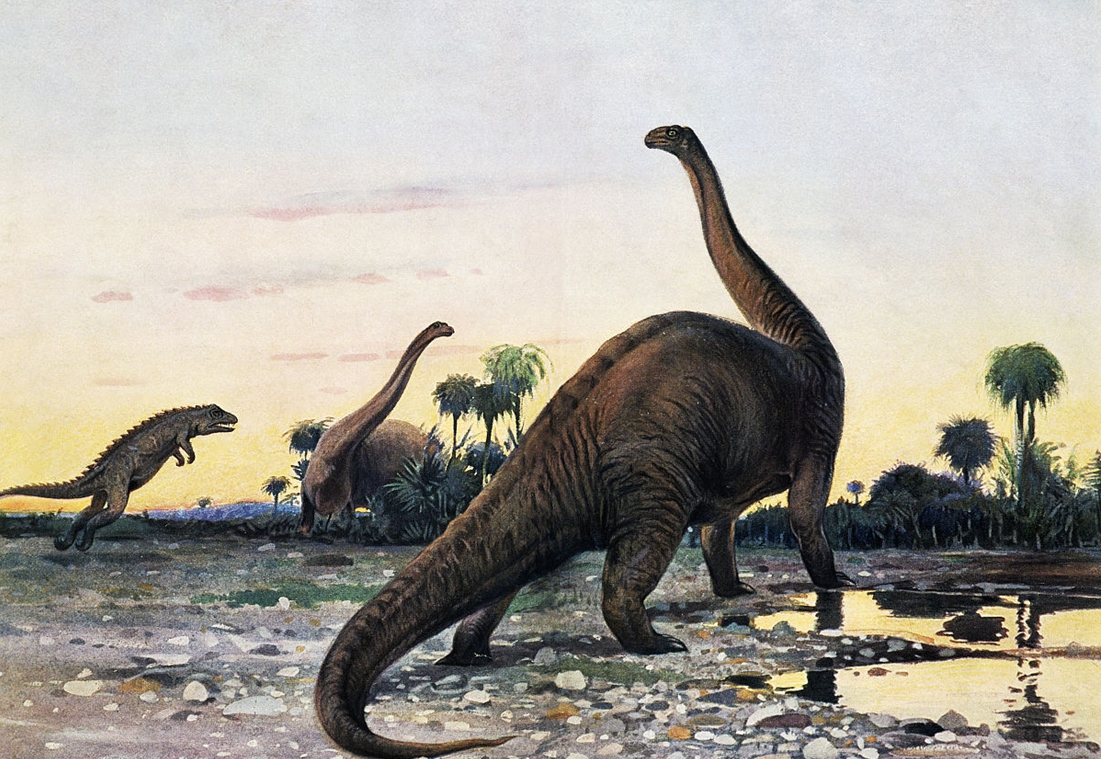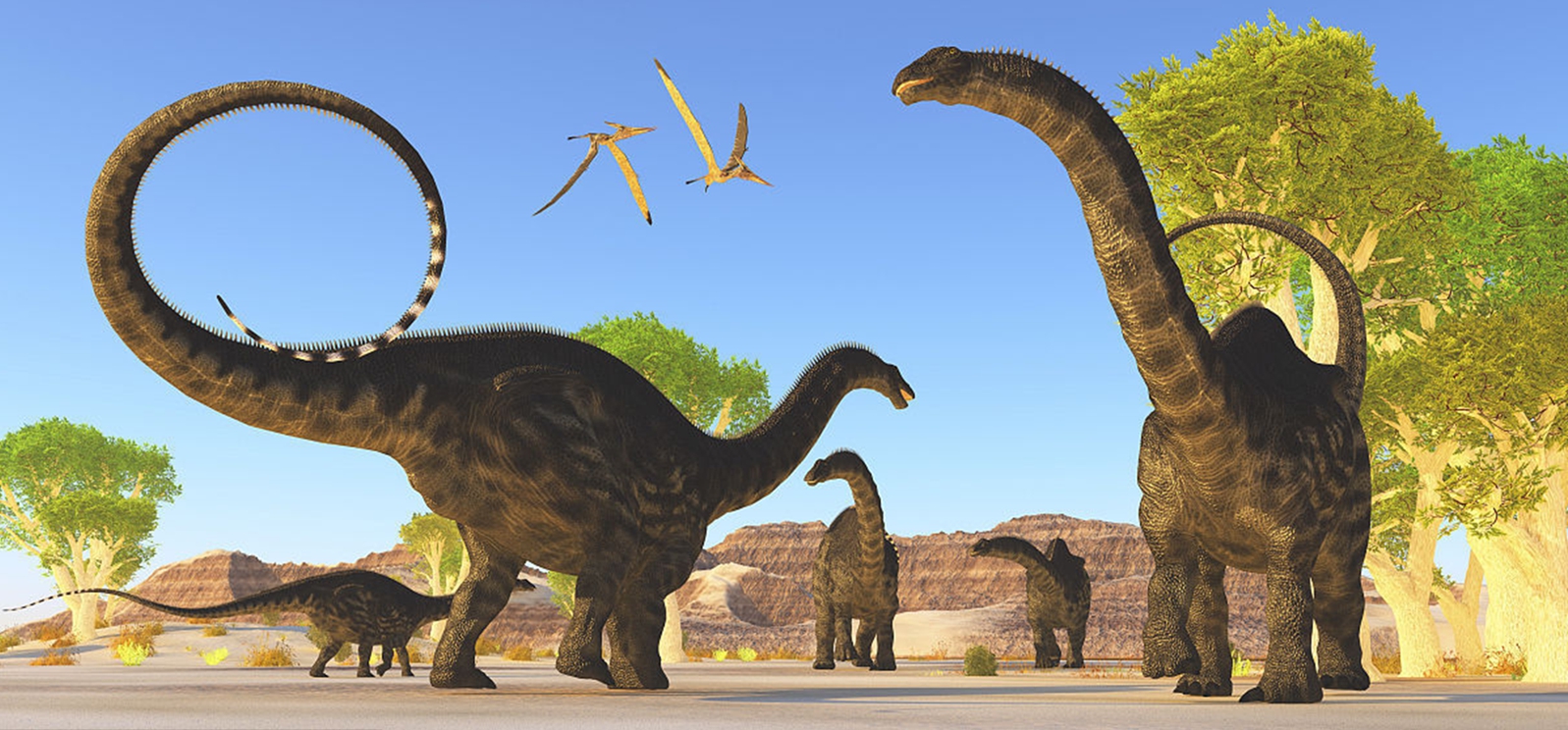Dinosaur Knowledge Tips Apatosaurus
Release time:2017/10/28 14:40:00

Apatosaurus (; meaning "deceptive lizard") is a genus of extinct sauropod dinosaurs that lived in North America during the Late Jurassic period. Othniel Charles Marsh described and named the first-known species, A. ajax, in 1877, and a second species, A. louisae, was discovered and named by William H. Holland in 1916. Apatosaurus lived about 152 to 151 million years ago (mya), during the early Tithonian age, and are now known from fossils in the Morrison Formation of modern-day Colorado, Oklahoma, New Mexico, and Utah in the United States. Apatosaurus had an average length of 21–22.8 m (69–75 ft), and an average mass of
16.4–22.4 t (16.1–22.0 long tons; 18.1–24.7 short tons). A few specimens
indicate a maximum length of 11–30% greater than average and a mass of
32.7–72.6 t (32.2–71.5 long tons; 36.0–80.0 short tons).
The cervical vertebrae of Apatosaurus are less elongated and more heavily constructed than those of Diplodocus, a diplodocid like Apatosaurus, and the bones of the leg are much stockier despite being longer, implying that Apatosaurus was a more robust animal. The tail was held above the ground during normal locomotion. Apatosaurus had a single claw on each forelimb and three on each hindlimb. The Apatosaurus skull, long thought to be similar to Camarasaurus, is much more similar to that of Diplodocus. Apatosaurus was a generalized browser that likely held its head elevated. To lighten its vertebrae, Apatosaurus had air sacs that made the bones internally full of holes. Like that of other
diplodocids, its tail may have been used as a whip to create loud
noises.
The skull of Apatosaurus was confused with that of Camarasaurus and Brachiosaurus until 1909, when the holotype of A. louisae was found, and a complete skull just a few meters away from the front of the neck. Henry Fairfield Osborn disagreed with this association, and went on to mount a skeleton of Apatosaurus with a Camarasaurus skull cast. Until 1970, Apatosaurus skeletons were mounted with speculative skull casts, when McIntosh showed that more robust skulls assigned to Diplodocus were more likely from Apatosaurus.
Apatosaurus is a genus in the family Diplodocidae. It is one of the more basal genera, with only Amphicoelias and possibly a new, unnamed genus more primitive. While the subfamily Apatosaurinae was named in 1929, the group was not used validly until an extensive 2015 study. Only Brontosaurus is also in the subfamily, with the other genera being considered synonyms or reclassified as diplodocines. Brontosaurus has long been considered a junior synonym of Apatosaurus; its only species was reclassified as A. excelsus in 1903. A 2015 study concluded that Brontosaurus is a valid genus of sauropod distinct from Apatosaurus, but not all paleontologists agree with this division. As it existed in North America during the late Jurassic, Apatosaurus would have lived alongside dinosaurs such as Allosaurus, Camarasaurus, Diplodocus, and Stegosaurus.

Apatosaurus was a large, long-necked, quadrupedal animal with a long, whip-like tail. Its forelimbs were slightly shorter than its hindlimbs. Most size estimates are based on specimen CM 3018, the type specimen of A. louisae. In 1936 this was measured to be 21.8 m (72 ft), by measuring the vertebral column. Current estimates are similar, finding that the individual was
21–22.8 m (69–75 ft) long and had a mass of 16.4–22.4 t (16.1–22.0 long
tons; 18.1–24.7 short tons). A 2015 study that estimated the mass of volumetric models of Dreadnoughtus, Apatosaurus, and Giraffatitan estimates CM 3018 at 21.8–38.2 t (21.5–37.6 long tons; 24.0–42.1 short tons), similar in mass to Dreadnoughtus. Past estimates have put the creature's mass as high as 35.0 t (34.4 long tons; 38.6 short tons). Some specimens of A. ajax (such as OMNH 1670) represent individuals 11–30% longer, suggesting masses twice that of CM 3018 or 32.7–72.6 t (32.2–71.5 long tons; 36.0–80.0 short tons), potentially rivalling the largest titanosaurs.
The skull is small in relation to the size of the animal. The jaws are lined with spatulate (chisel-like) teeth suited to an herbivorous diet. The snout of Apatosaurus and similar diplodocoids is squared, with only Nigersaurus having a squarer skull. The braincase of Apatosaurus is well preserved in specimen BYU 17096,
which also preserved much of the skeleton. A phylogenetic analysis
found that the braincase had a morphology similar to those of other
diplodocoids. Some skulls of Apatosaurus have been found still in articulation with their teeth. Those teeth that have the enamel surface exposed do not show any scratches on the surface; instead, they display a sugary texture and little wear.
Like those of other sauropods, the neck vertebrae are deeply
bifurcated; they carried neural spines with a large trough in the
middle, resulting in a wide, deep neck. The vertebral formula for the holotype of A. louisae is 15 cervicals, 10 dorsals, 5 sacrals, and 82 caudals. The caudal vertebra number may vary, even within species. The cervical vertebrae of Apatosaurus and Brontosaurus are stouter and more robust than those of other diplodocids and were found to be most similar to Camarasaurus by Charles Whitney Gilmore. In addition, they support cervical ribs that extend farther towards the ground than in diplodocines, and have
vertebrae and ribs that are narrower towards the top of the neck, making
the neck nearly triangular in cross-section. In Apatosaurus louisae, the atlas-axis complex of the first cervicals is nearly fused. The dorsal ribs are not
fused or tightly attached to their vertebrae and are instead loosely
articulated. Apatosaurus has ten dorsal ribs on either side of the body. The large neck was filled with an extensive system of weight-saving air sacs. Apatosaurus, like its close relative Supersaurus,
has tall neural spines, which make up more than half the height of the
individual bones of its vertebrae. The shape of the tail is unusual for a
diplodocid; it is comparatively slender because of the rapidly
decreasing height of the vertebral spines with increasing distance from
the hips. Apatosaurus also had very long ribs compared to most other diplodocids, giving it an unusually deep chest. As in other diplodocids, the tail transformed into a whip-like structure towards the end.
The limb bones are also very robust. Within Apatosaurinae, the scapula of Apatosaurus louisae is intermediate in morphology between those of A. ajax and Brontosaurus excelsus. The arm bones are stout, so the humerus of Apatosaurus resembles that of Camarasaurus, as well as Brontosaurus. However, the humeri of Brontosaurus and A. ajax are more similar to each other than they are to A. louisae. In 1936 Charles Gilmore noted that previous reconstructions of Apatosaurus forelimbs erroneously proposed that the radius and ulna could cross; in life they would have remained parallel. Apatosaurus had a single large claw on each forelimb, a feature shared by all sauropods more derived than Shunosaurus. The first three toes had claws on each hindlimb. The phalangeal formula
is 2-1-1-1-1, meaning the innermost finger (phalanx) on the forelimb
has two bones and the next has one. The single manual claw bone (ungual) is slightly curved and squarely truncated on the anterior end. The pelvic girdle includes the robust ilia, and the fused (co-ossified) pubes and ischia. The femora of Apatosaurus are very stout and represent some of the most robust femora of any
member of Sauropoda. The tibia and fibula bones are different from the
slender bones of Diplodocus but are nearly indistinguishable from those of Camarasaurus. The fibula is longer and slenderer than the tibia. The foot of Apatosaurus has three claws on the innermost digits; the digit formula is
3-4-5-3-2. The first metatarsal is the stoutest, a feature shared among
diplodocids.

from Wikipedia